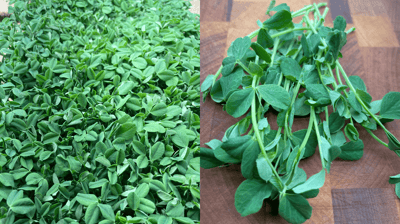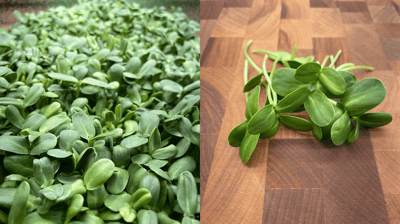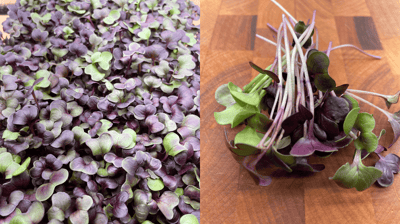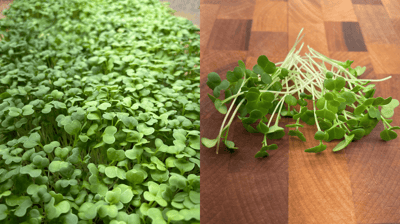Our Greens
Did you know that, ounce for ounce, microgreens generally have 4–40 times higher nutrient concentrations than their mature vegetable counterparts?
See below for a complete list of what we grow!
Pea (Speckled)
Look, Smell & Taste:
Bright green vines with delicate tendrils and paired oval leaves. Mildly grassy aroma with a sweet, crisp taste reminiscent of sugar snap peas.
Common Uses:
Fresh salads and wraps
Smoothies
Garnish for soups and pasta
Nutritional Highlights:
High in Vitamin C, Vitamin A, and folate
Good source of fiber and plant protein
Key Antioxidants:
Vitamin C (ascorbic acid)
Lutein & Zeaxanthin (support eye health)
Sunflower (Black Oil)
Look, Smell & Taste:
Thick, crunchy stems with large, bright green leaves. Nutty and earthy aroma; flavor is crunchy, mildly sweet, and sunflower seed-like.
Common Uses:
Base for salads
Sandwich filler
Juices and smoothies
Nutritional Highlights:
Rich in Vitamin E, selenium, and B vitamins
High in protein and healthy fats
Key Antioxidants:
Vitamin E (alpha-tocopherol)
Chlorogenic acid & Caffeic acid (phenolic compounds)






Radish (Sango Purple)
Look, Smell & Taste:
Vibrant green tops with pink to purple stems. Strong, peppery aroma and a sharp, spicy flavor similar to mature radishes.
Common Uses:
Spicy addition to salads and sandwiches
Garnish for tacos or noodle dishes
Nutritional Highlights:
High in Vitamin C, folate, and potassium
Contains anti-inflammatory compounds
Key Antioxidants:
Vitamin C
Raphanin (glucosinolate) → metabolizes into isothiocyanates
Beet (Detroit Dark Red)
Look, Smell & Taste:
Stunning red stems with green or burgundy leaves. Earthy and mildly sweet aroma. Taste is sweet, earthy, and beet-like but more tender.
Common Uses:
Visual and flavor pop in salads
Garnish for soups, cheese boards
Nutritional Highlights:
Rich in folate, potassium, manganese, and Vitamin C
Supports heart and liver health
Key Antioxidants:
Betalains (especially betanin and vulgaxanthin)
Lutein
Vitamin C
Mustard (Komatsuna)
Look, Smell & Taste:
Tender green leaves, often tinged with purple or red. Sharp, pungent mustard scent. Bold, spicy flavor similar to horseradish or Dijon mustard.
Common Uses:
Kick of spice in sandwiches and egg dishes
Garnish for meat or savory entrees
Nutritional Highlights:
Rich in Vitamins A, C, and K
Contains anti-inflammatory phytochemicals
Key Antioxidants:
Sinigrin (glucosinolate) → converts to allyl isothiocyanate
Quercetin & Kaempferol (flavonoids)
Beta-carotene (precursor to Vitamin A)






Cabbage (Golden Acre)
Look, Smell & Taste:
Small, round to heart-shaped leaves with dark green hues. Mild, slightly earthy cruciferous scent. Taste is slightly sweet with a faint cabbage flavor, much gentler than mature cabbage.
Common Uses:
Base or topping for fresh salads
Smoothie additive for a subtle green boost
Topping for sandwiches, tacos, or egg dishes
Nutritional Highlights:
High in Vitamin C and Vitamin K
Good source of beta-carotene (pro-vitamin A), calcium, and magnesium
Contains beneficial glucosinolates that aid detoxification and support immune health
Key Antioxidants:
Vitamin C
Beta-carotene – supports vision and skin health
Kaempferol & Quercetin (flavonoids)
Glucosinolates – converts into isothiocyanates that help protect cells and reduce inflammation
Healthy Food -- Real Skills -- Sustainable Living
